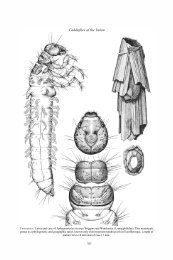Spiders of the Yukon - Department of Biological Sciences
Spiders of the Yukon - Department of Biological Sciences
Spiders of the Yukon - Department of Biological Sciences
You also want an ePaper? Increase the reach of your titles
YUMPU automatically turns print PDFs into web optimized ePapers that Google loves.
<strong>Spiders</strong> <strong>of</strong> <strong>the</strong> <strong>Yukon</strong> 81<br />
54. Microlinyphia pusilla (Sundevall) Holarctic, Subarctic/Alpine<br />
Distribution: Alaska and <strong>Yukon</strong> south in <strong>the</strong> Cordillera to Colorado; Europe, Asia, North Africa<br />
(Helsdingen 1970).<br />
<strong>Yukon</strong> records: Blackstone R., km 148 Dempster Hwy.<br />
<strong>Biological</strong> information: In deciduous leaf litter.<br />
55. Microneta viaria (Blackwall) Holarctic, Subarctic/Alpine<br />
Distribution: Alaska to Nova Scotia, south to New Mexico and Connecticut; Europe, Asia.<br />
<strong>Yukon</strong> records: km 203 and 260 Dempster Hwy.<br />
<strong>Biological</strong> information: On talus slopes and in shrub litter.<br />
56. Neriene radiata (Walckenaer) Holarctic, Boreal<br />
Distribution: Alaska to Newfoundland, south to California and Florida; Europe, Asia.<br />
<strong>Yukon</strong> records: Mayo.<br />
<strong>Biological</strong> information: On shrubs and lower branches <strong>of</strong> trees.<br />
57. Oreonetides vaginatus (Thorell) Holarctic, Boreal<br />
Distribution: Alaska to Greenland and Newfoundland, south to Arizona and nor<strong>the</strong>rn New England;<br />
Europe, Asia.<br />
<strong>Yukon</strong> records: North Fork Pass, Ogilvie Mts.<br />
<strong>Biological</strong> information: In plant litter in bogs and on alpine tundra.<br />
58. Pityohyphantes limitaneus (Emerton) Nearctic, Boreal<br />
Distribution: <strong>Yukon</strong> to Newfoundland, south to British Columbia, Ontario and Maine.<br />
<strong>Yukon</strong> records: Tack L. (67°28′N 139°41′W); Squana L., km 1350 Alaska Hwy.<br />
<strong>Biological</strong> information: On coniferous foliage.<br />
59. Pityohyphantes phrygianus (C.L. Koch) Holarctic, Boreal<br />
Distribution: Alaska to Newfoundland, south to Banff, Alberta and sou<strong>the</strong>astern Ontario; Europe,<br />
Asia.<br />
<strong>Yukon</strong> records: Squana L., km 1350 Alaska Hwy.<br />
<strong>Biological</strong> information: On coniferous foliage.<br />
Taxonomic notes: We resort to <strong>the</strong> name phrygianus for this species after comparison <strong>of</strong> North<br />
American specimens with some from Scandinavia. It is distinct from P. costatus (Hentz).<br />
60. Poeciloneta furcata (Emerton) Nearctic, Boreal<br />
Distribution: <strong>Yukon</strong> to New Hampshire.<br />
<strong>Yukon</strong> records: Cultus Bay, Kluane National Park.<br />
<strong>Biological</strong> information: In litter.<br />
61. Poeciloneta petrophila Tanasevitch** East-West Beringian, Arctic<br />
Distribution: <strong>Yukon</strong>; eastern Siberia (Tanasevitch 1989a).<br />
<strong>Yukon</strong> records: km 82 (North Fork Pass) and 155 (Windy Pass) Dempster Hwy.<br />
<strong>Biological</strong> information: Under stones.<br />
62. Poeciloneta variegata (Blackwall) Holarctic, Subarctic/Alpine<br />
Distribution: Alaska to Washington; Siberia (Tanasevitch 1989a).<br />
<strong>Yukon</strong> records: Cultus Bay, Kluane National Park.<br />
<strong>Biological</strong> information: Under stones above treeline.<br />
Taxonomic notes: As Tanasevitch (1989a) has shown, <strong>the</strong> published records <strong>of</strong> P. globosa (Wider)<br />
subsequent to <strong>the</strong> original description pertain to P. variegata.<br />
Family Erigonidae<br />
Sometimes referred to as dwarf spiders, <strong>the</strong> erigonids rarely exceed 2 mm in body length.<br />
The majority are litter dwellers that feed on springtails and similar prey. One hundred and<br />
two species, or about a third <strong>of</strong> all <strong>Yukon</strong> spider species, are recorded from <strong>the</strong> <strong>Yukon</strong> to<br />
date, but, because <strong>of</strong> <strong>the</strong>ir obscure lifestyles, small size, and difficulty <strong>of</strong> identification, many<br />
additional species are expected to come to light with fur<strong>the</strong>r collecting.

















